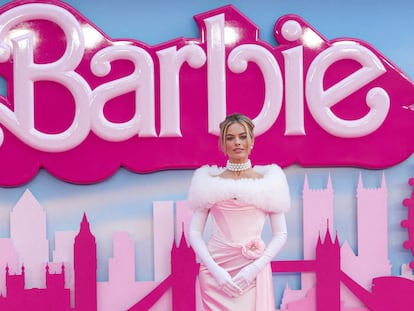Progress toward parity for women on movie screens has stalled, report finds
For every woman as a speaking character in the most popular films of 2022, there were more than two men, according to report by University of Southern California’s Annenberg Inclusion Initiative

A new study on inclusion in film shows just how much of a rarity Barbie is. For every woman as a speaking character in the most popular films of 2022, there were more than two men, according to a report by University of Southern California’s Annenberg Inclusion Initiative.
The USC report, published Thursday, found that 34.6% of speaking parts were female in the top 100 box-office hits of last year. The Annenberg Inclusion Initiative has been annually tracking that and many other metrics since 2007.
And in its first such study in three years, USC researchers found that in many areas, progress toward parity on screen has stalled since the pandemic — and in some respects hasn’t changed all that much since 14 years ago. In 2019, 34% of speaking characters were female. In 2008, it was 32.8%.
“It is clear that the entertainment industry has little desire or motivation to improve casting processes in a way that creates meaningful change for girls and women,” said Stacy L. Smith, founder and director of the Inclusion Initiative, in a statement. “The lack of progress is particularly disappointing following decades of activism and advocacy.”
In analyzing the top films in ticket sales, the report doesn’t include the large amount of films produced for streaming platforms and smaller releases. But it does offer a snapshot of how Hollywood is evolving — or not.
And it comes on the heels of the enormous success of Greta Gerwig’s Barbie, which has made $1.2 billion worldwide since opening last month and domestically has become the highest grossing movie ever from a female filmmaker. Last year, one in 10 of the biggest box-office films were directed by women, down from record rates in 2019, 2020 and 2021.
Some findings in the study point to progress in inclusivity on screen. There are more female leading or co-leading roles in the top grossing movies than ever. Some 44% of such lead roles were girls or women in 2022, a historical high and more than double the rate of 2007 (20%).
Speaking characters from underrepresented ethnic groups have also made sizable gains. In 2022, Black, Hispanic, Asian and other non-white minorities accounted for 38.3% of speaking characters, nearly matching the U.S. population percentage of 41%. Most notably, Asian characters have gone from 3.4% of characters in 2007 to 15.9% last year, a movie year that culminated with the best picture win for “Everything Everywhere All at Once.”
But other metrics show that the film industry regressed in some areas of diversity during the pandemic. In 2022, the top grossing movies featured 31% of leads from underrepresented ethnic groups, down from 37% in 2021. Out of those 100 2020 movies, 46 didn’t include a Latino speaking character.
“These trends suggest that any improvement for people from underrepresented racial/ethnic groups is limited,” said Smith. “While it is encouraging to see changes for leading characters and for the Asian community, our data on invisibility suggests that there is still much more to be done to ensure that the diversity that exists in reality is portrayed on screen.”
Of the top 100 films in 2022, just 2.1% of speaking characters were LGBTQ+ — roughly the same number as a decade ago. Of the 100 films, 72 didn’t feature a single LGBTQ+ character. Only one was nonbinary.
The number of characters with disabilities has also flatlined. In 2022, 1.9% of speaking characters were depicted with a disability. In 2015, the percentage was 2.4%.
With actors and screenwriters striking over fair pay, AI and other issues, Smith said Thursday’s report should add to the demands of workers on screen and off in Hollywood.
“When people from these communities are rendered invisible both on screen and behind the camera, the need to ensure that every opportunity merits a living wage is essential. This cannot happen if people are not working at all,” said Smith. “Hollywood has a long road ahead to address the exclusion still happening in the industry, alongside the concerns actors and writers are bringing to the forefront.”
Sign up for our weekly newsletter to get more English-language news coverage from EL PAÍS USA Edition
Tu suscripción se está usando en otro dispositivo
¿Quieres añadir otro usuario a tu suscripción?
Si continúas leyendo en este dispositivo, no se podrá leer en el otro.
FlechaTu suscripción se está usando en otro dispositivo y solo puedes acceder a EL PAÍS desde un dispositivo a la vez.
Si quieres compartir tu cuenta, cambia tu suscripción a la modalidad Premium, así podrás añadir otro usuario. Cada uno accederá con su propia cuenta de email, lo que os permitirá personalizar vuestra experiencia en EL PAÍS.
¿Tienes una suscripción de empresa? Accede aquí para contratar más cuentas.
En el caso de no saber quién está usando tu cuenta, te recomendamos cambiar tu contraseña aquí.
Si decides continuar compartiendo tu cuenta, este mensaje se mostrará en tu dispositivo y en el de la otra persona que está usando tu cuenta de forma indefinida, afectando a tu experiencia de lectura. Puedes consultar aquí los términos y condiciones de la suscripción digital.
More information
Archived In
Últimas noticias
Most viewed
- Sinaloa Cartel war is taking its toll on Los Chapitos
- Oona Chaplin: ‘I told James Cameron that I was living in a treehouse and starting a permaculture project with a friend’
- Reinhard Genzel, Nobel laureate in physics: ‘One-minute videos will never give you the truth’
- Why the price of coffee has skyrocketed: from Brazilian plantations to specialty coffee houses
- Silver prices are going crazy: This is what’s fueling the rally










































